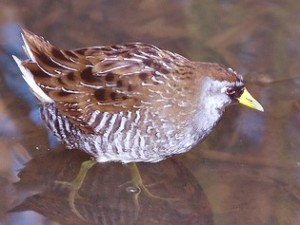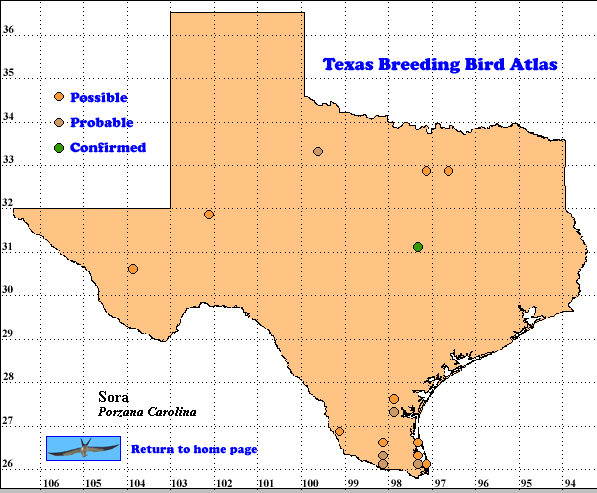These medium-sized, short-billed rails are the most common and widespread members of this group in North America. Their distinctive, descending “whinny”, separates them vocally from other marsh birds, while their bills are much shorter than those of the three Rallus species, the next most commonly seen rails. Like their compatriots, Soras skulk through cattails or other emergent plants, occasionally swimming across open water or following the edge of a reedbed.
While the nests and eggs of Soras are very similar to those of the similar-sized Virginia Rails (Rallus limicola), the food habitats of these two species differ considerably. The latter prefer aquatic invertebrates and small fish, while the chicken-like bills of Soras are best adapted to gathering seeds of aquatic plants from the surface of the water, although as chickens do, Soras also catch insects they stir up while walking (Melvin and Gibbs 1996). As Lockwood and Freeman (2004) note, rice fields in the fall attract large numbers of Soras, presumably as they glean waste rice grains.
DISTRIBUTION. During the 1987-1992 field work seasons of the TBBA project, atlasers found one confirmed, 5 probable and 12 possible breeding sites for Soras, mostly in the Coastal Sand Plain and southern South Texas Brush Country regions (see the region map in Lockwood and Freeman [2004]). In Oklahoma atlasers did not find breeding evidence for Soras (Reinking 2004).
North American Breeding Bird Survey observers found the highest relative abundances (3-10 Soras per route) on the northern prairies in Alberta, Saskatchewan, Manitoba and North Dakota. Breeding season reports also came from other southern Canadian provinces, the Pacific Northwest, the Intermountain West, the northern and central Rocky Mountain states, the northern Great Plains and Minnesota an Wisconsin (Sauer et al. 2008). These rails also breed as fat north as southeast Alaska and northwest Canada and south to northern Baja California, Mexico. They winter on the Pacific and Atlantic coast from Washington and the Delmarva Peninsula south, the Gulf Coast and the southwestern United States, Mexico, Central America, the West Indies and northern South America (Howell and Webb 1995, Melvin and Gibbs 1996, Am. Ornithol. Union 1998, Paulson 2005).
SEASONAL OCCURRENCE. Soras are uncommon to locally common migrants throughout Texas from early March to mid-May and late August to early November. These rails are common to locally abundant migrants and winter residents along the Coastal Prairies (Oberholser 1974, Lockwood and Freeman 2004). In Colorado young were found from May 21 to August 12. Two-thirds of the dates were in July, with the latest probably representing second broods (Pantle 1998).
BREEDING HABITAT. Almost all breeding evidence in Arizona and Colorado for Soras was obtained at wetlands edged with cattails, rushes and other emergent plants (Pantle 1998, Shrout 2005). In these situations a pile of dead cattail blades or bulrushes is gathered and the female lays the first egg on top. Using materials gathered by her mate, she weaves a basket, attached to and supported by surrounding stems of nearby vegetation. The nest may be at the water’s surface, dip slightly into it or be above water level. The adjacent plants arch over the nest and are attached to the nest rim to form a canopy. A ramp from the water to the nest rim is often added and total construction time is about one week (Harrison 1979,Melvin and Gibbs (1996).
Average dimensions are: outside diameter 15 cm (6 in), height of the nest rim above water 12 cm (4.6 in), cup depth 6 cm (2.4 in) and inside diameter 11 cm (4.4 in). Empty Sora nests are indistinguishable from those of Virginia Rails. See Harrison (1979) for nest photos of these two rails. In the nest the female usually lays 9-11 (range 5-18) smooth, glossy, rich buff eggs, irregularly spotted with shades of brown. The eggs, laid one per day, are more richly colored, heavily spotted and glossier than those of Virginia Rails. After the first few eggs have been laid, both sexes share incubation for an average of 19 days (range 11-22; Harrison 1979,Melvin and Gibbs (1996).
During the hatching period one parent may still be incubating while the other cares for newly hatched, precocial young and other chicks are hatching. One day after hatching, chicks can run and swim. They leave the nest at 3-4 days of age and begin to forage, although they receive some food from their parents for several weeks. Newly hatched chicks are brooded part of the daylight hours and all night. Daytime brooding decreases more rapidly, but some nocturnal brooding may continue until the young are capable of flight at about 4 weeks old. At 6 weeks they are adult size (Harrison 1979,Melvin and Gibbs (1996).
STATUS. Soras are rare summer residents and breeders throughout Texas. Breeding is also irregular at any given location (Lockwood and Freeman 2004). Data from 495 BBS routes across North America suggest a relatively stable population size for the period 1980-2007 (Sauer et al. 2008). The impact of legal hunting on this rail has not been studied. Coastal marshes in Texas and other states are important winter habitats for Soras (Melvin and Gibbs 1996). These are threatened by a variety of factors including more frequent major storms and pollution.
Text by Robert C. Tweit (2008)
Literature cited.
American Ornithologists’ Union. 1998. Checklist of North American birds, 7th ed. Am, Ornithol. Union, Washington, DC.
Harrison, H. H. 1979. A field guide to western birds’ nests. Houghton Mifflin, Boston, MA.
Howell, S. N. G. and S. Webb. 1995. A guide to the birds of Mexico and northern Central America. Oxford University Press, New York.
Lockwood, M. W. and B. Freeman. 2004. The TOS handbook of Texas birds. Texas A&M University Press, College Station.
Melvin, S. M. and J. P. Gibbs. 1996. Sora (Porzana carolina), The Birds of North America Online (A. Poole, Ed.). Ithaca: Cornell Lab of Ornithology; Retrieved from: http://bna.birds.cornell.edu/bna/species/250
Oberholser, H. C. 1974. The bird life of Texas. University of Texas Press, Austin.
Pantle, D. 1998. Sora (Porzana carolina). In Colorado breeding bird atlas, pp. 156-157 (H. E. Kingery, ed.), Colorado Bird Atlas Partnership, Denver.
Paulson, I. 2005. Sora (Porzana carolina). In Birds of Washington: status and distribution. p 129 (T. R. Wahl, B. Tweit and S. G. Mlodinow, eds.) Oregon State University Press, Corvallis.
Reinking, D. L., ed. 2004. Oklahoma breeding bird atlas. University of Oklahoma Press, Norman.
Sauer, J. R., J. E. Hines, and J. Fallon. 2008. The North American breeding bird survey, results and analysis 1966-2007. Version 5.15.2008. USGS Patuxent Wildlife Research Center, Laurel MD < http://www.mbr-pwrc.usgs.gov/bbs>
Shrout, N. 2005.Sora (Porzana carolina). In Arizona breeding bird atlas. pp. 166-167 (T. E. Corman and C. Wise-Gervais, eds.), University of New Mexico Press, Albuquerque.

